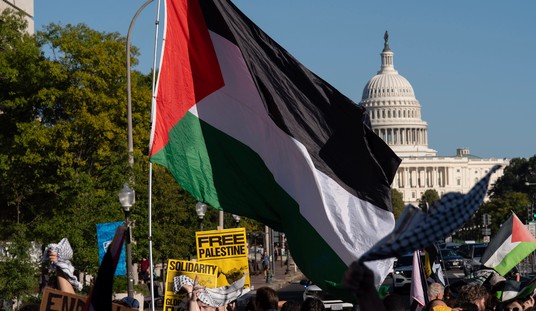A jihadist Twitter account said the leader of the al Qaeda-linked Khorasan group was killed in a U.S. air strike in Syria, SITE monitoring service said on Sunday after several days of uncertainty over whether he survived the raid.
A U.S. official said on Sept. 24 the United States believed Mohsin al-Fadhli, a senior al Qaeda operative, had been killed in a strike a day earlier, but the Pentagon said several hours later it was still investigating what had happened to him.
At some point in the last few years, al Qaeda’s top commanders — including its leader, Ayman al-Zawahiri — reportedly ordered Fahdli to set up shop in rebel-controlled areas of Syria.
Thomas H. Henriksen, senior fellow at the Hoover Institution at Stanford University and an expert on US terrorism policy, told VICE News that the choice of location didn’t have to do with the fight against Assad’s regime or the conflict among the Syria’s rebel groups, but rather with its convenience amid a power vacuum.
Mayville echoed this characterization, describing Khorasan as “clearly not focused on either the Assad regime or the Syrian people. They are establishing roots in Syria in order to advance attacks against the West and the homeland.”
The U.S. ability to pinpoint with airstrikes the operational hubs of the al Qaeda offshoot Khorasan Group in Syria and penetrate one of its bombing plots shows the importance of the much-maligned National Security Agency, defense analysts said Tuesday.
The Khorasan Group is an especially hard target because, unlike other al Qaeda spinoffs, it stays in the shadows and refrains from pronouncements on social media. Its goal is to design explosives that can defeat airport security and blow up an airliner, killing hundreds of people. Its prime target: the United States…
Defense analysts said that signals intelligence or Sigint — the result of intercepted communications — likely played a major role because developing spies in war-wracked Syria has been difficult at best and often results in unreliable information.
Only the U.S.—not Arab allies—struck sites associated with the Khorasan group, officials said. Khorasan group members were in the final stages of preparations for an attack on U.S. and Western interests, a defense official said. Khorasan was planning an attack on international airliners, officials have said…
Rebels and activists contacted inside Syria said they had never heard of Khorasan and that the U.S. struck several bases and an ammunition warehouse belonging to the main al Qaeda-linked group fighting in Syria, Nusra Front.
While U.S. officials have drawn a distinction between the two groups, they acknowledge their membership is intertwined and their goals are similar.
The group’s evolution from obscurity to infamy has been sudden: The first time President Obama publicly mentioned the group was on Tuesday, when he announced he had ordered an airstrike against it to disrupt what American officials said was a terror plot aimed at the West…
The focus on the Khorasan Group in recent days has, at least for the moment, diverted attention from the Islamic State, the militant group whose recent battlefield successes were Mr. Obama’s original reason for launching airstrikes. It has also underscored the enduring relevance of Al Qaeda’s leadership apparatus in Pakistan, a group that Mr. Obama told the United Nations on Wednesday had been badly battered.
“There’s a contradiction here,” said Bruce O. Riedel, a former C.I.A. analyst now at the Brookings Institution. “If they are that decimated, why are we so alarmed when we detect new evidence of their activities?”
What happened here is all-too-familiar. The Obama administration needed propagandistic and legal rationale for bombing yet another predominantly Muslim country. While emotions over the ISIS beheading videos were high, they were not enough to sustain a lengthy new war.
So after spending weeks promoting ISIS as Worse Than Al Qaeda™, they unveiled a new, never-before-heard-of group that was Worse Than ISIS™. Overnight, as the first bombs on Syria fell, the endlessly helpful U.S. media mindlessly circulated the script they were given: this new group was composed of “hardened terrorists,” posed an “imminent” threat to the U.S. homeland, was in the “final stages” of plots to take down U.S. civilian aircraft, and could “launch more-coordinated and larger attacks on the West in the style of the 9/11 attacks from 2001.””
As usual, anonymity was granted to U.S. officials to make these claims. As usual, there was almost no evidence for any of this. Nonetheless, American media outlets — eager, as always, to justify American wars — spewed all of this with very little skepticism. Worse, they did it by pretending that the U.S. government was trying not to talk about all of this — too secret! — but they, as intrepid, digging journalists, managed to unearth it from their courageous “sources.” Once the damage was done, the evidence quickly emerged about what a sham this all was. But, as always with these government/media propaganda campaigns, the truth emerges only when it’s impotent.
Last night I wrote about the “Khorasan Group” — the name used to describe operatives sent by al Qaeda to Syria for the purpose of plotting attacks against the West. In discussing the unusual name attached to these operatives, I quoted two experts on terrorism who speculated in the Washington Post that the name was supplied by Washington…
Today, the invaluable Tom Joscelyn informed me that the name doesn’t come from Washington. He says: “Although they haven’t used Khorasan publicly to describe themselves, that name is actually taken from the Khorasan shura with al Qaeda, which is a specific advisory council.”
The Post’s sources emphasized that the name isn’t familiar in Syria. But, according to Tom, that’s because this is an internal AQ body, and not something marketed to the public.
There is a reason that no one had heard of such a group until a nanosecond ago, when the “Khorosan Group” suddenly went from anonymity to the “imminent threat” that became the rationale for an emergency air war there was supposedly no time to ask Congress to authorize.
You haven’t heard of the Khorosan Group because there isn’t one. It is a name the administration came up with, calculating that Khorosan — the –Iranian–Afghan border region — had sufficient connection to jihadist lore that no one would call the president on it.
The “Khorosan Group” is al-Qaeda. It is simply a faction within the global terror network’s Syrian franchise, “Jabhat al-Nusra.” Its leader, Mushin al-Fadhli (believed to have been killed in this week’s U.S.-led air strikes), was an intimate of Ayman al-Zawahiri, the emir of al-Qaeda who dispatched him to the jihad in Syria. Except that if you listen to administration officials long enough, you come away thinking that Zawahiri is not really al-Qaeda, either. Instead, he’s something the administration is at pains to call “core al-Qaeda.”…
Obama is not the manner of man who can say, “I was wrong: It turns out that al-Qaeda is actually on the rise, its Islamic State faction is overwhelming the region, and American interests — perhaps even American territory — are profoundly threatened.” So instead . . . you got “the Khorosan Group.”
You say that Al-Qaeda’s on the run. Okay, that becomes the “fact.” That reality can’t change, except it isn’t real. If you say Al-Qaeda’s on the run, they have to remain on the run.
That’s tied to the president. He said so. He’s the commander-in-chief. Well, they’re not on the run. Okay, so what do you do? You invent this new group; give them a new name. They’re the same group, but you call ’em the Khorasan group. And that’s, pure and simple, why this is going on. But the bottom line is it’s the same bunch of people, same organization, same objectives.
They’re not on the run, they have not been pushed back, they’ve not been dealt with. None of that, none of that was true. The Democrats — if you remember, shortly after 9/11 when we started get going with the war in Afghanistan, and then we went to Iraq. The Democrats all said, “That’s not the place to go! You gotta go to Afghanistan. This thing’s not over ’til you kill bin Laden! You gotta kill bin Laden! That’s how you define victory!”
A lot of us said, “No, that isn’t gonna matter. Al-Qaeda is still gonna be around.” But they actually believed it, ’cause they think we killed bin Laden and that meant the end of Al-Qaeda politically as far as they were concerned. So they’ve got a mess on their hands because there’s no principle.
The confusion is no accident. The way President Obama, his subordinates, and some US intelligence officials think and talk about al Qaeda is wrong…
[T]he so-called Khorasan group is part of core al Qaeda. The idea that terrorists cannot be core al Qaeda solely because they are located outside of Afghanistan and Pakistan is obtuse. Documents recovered in Osama bin Laden’s compound show that the al Qaeda master ordered some of his minions out of the drones’ kill box in northern Pakistan and maintained ongoing communications with terrorists around the globe. The general manager of al Qaeda’s global network today is in Yemen…
What administration officials also ignore is that al Qaeda’s geographic expansion, or “metastasis,” has always been part of the plan. Despite al Qaeda’s leadership disputes with ISIL, there are more jihadist groups openly loyal to al Qaeda today than on 9/11 or when Barack Obama took office in January 2009. Earlier this month, the group announced the creation of a fifth regional branch, Al Qaeda in the Indian Subcontinent (AQIS), which likely subsumes several existing jihadist organizations. On Sept. 6, AQIS-trained fighters boarded a Pakistani ship. Al Qaeda says they were attempting to launch missiles at an American warship, which would have been catastrophic, both in terms of the immediate damage and the ensuing political crisis in Pakistan. AQIS joins Al Qaeda in the Arabian Peninsula (AQAP), Al Qaeda in the Islamic Maghreb (AQIM), Jabhat al Nusrah (Syria), and Al Shabaab (Somalia) as formal branches of al Qaeda, all of which owe their loyalty to Zawahiri. Other unannounced branches of al Qaeda probably exist, too. These are not just “cells,” as Rice put it, but fully developed insurgency organizations that challenge governments for control of nation-states.
But linking the US bombing campaign in Syria to Al Qaeda, rather than, say, simply the Islamic State, does matter. While the War Powers Act requires the president to seek congressional approval within 60 days of launching military action, the White House has invoked the 2001 Authorization for the Use of Military Force (AUMF) against Al Qaeda as the basis for its actions.
By relying on the 2001 authorization to justify its use of force, the White House can claim that it does not need to return to Congress in 60 days for authorization, because it already has it…
While he can recognize the skepticism that many Americans bring to US officials’ claims of an “imminent threat,” particularly given the weapons of mass destruction warnings in the run-up the Iraq War that turned out to be false, retired Lt. Gen. David Barno says that he believes the threats about a group with lingering Al Qaeda ties are “accurate.”
He cites a comment from outgoing Attorney General Eric Holder, who told NBC on Friday, “We’d been following them for two years.”
There are some interesting puzzles raised by this episode.
One is why President Obama’s claims about newly emerging terrorist threats are not greeted with greater skepticism. One often hears these days that if President Bush had done these things, there would be much more (and faster) doubt and outrage. Three factors might explain this. First, war fever induced by the beheadings might lead many more people than usual not to question the basis for the current airstrikes. Second, Obama is acting against his perceived natural disposition as anti-war, and thus can act in this direction with fewer questions than could President Bush, who had the opposite reputation. Despite his pretty relentless war unilateralism, the President is still widely viewed as a reluctant warrior, and thus when he goes to war there is less skepticism (compared to even the pre-Iraq Bush) about its basis. It’s the “Nixon Goes to China” phenomenon. (Here is a famous academic paper about it.) A similar phenomenon with the opposite impact was in play when President Bush got no grief for releasing GTMO detainees or trying terrorists in civilian courts, yet Obama receives much grief for the same things. Third, the politics line up in ways that tamp down skepticism of the President’s war motivations, since his natural critics, Republicans, are generally more belligerent than he is, and the Democrats, while more skeptical of war, don’t want to unduly hurt the President…
I thus think this is a situation where presidential credibility about a new terrorist threat can only be tested over time, through ex post scrutiny, by journalists and others who can take more time to verify claims, and also from leakers. In theory, a rational president will anticipate ex post scrutiny and not mislead in the short term in a way that will be politically harmful later. President Bush’s credibility about threat reports plummeted, and never really recovered, after it became clear that Saddam Hussein did not possess WMD. That said, I tend to doubt that Obama will get much ex post political heat if his administration has in fact exaggerated the imminence of the KG threat. This is a significant advantage that flows to President Obama from his preference for pinprick war from a distance (drones, manned airstrikes, cyber) with little possible harm to U.S. troops: It invites much less ex post scrutiny at home, compared to a large footprint and body bags.








Join the conversation as a VIP Member